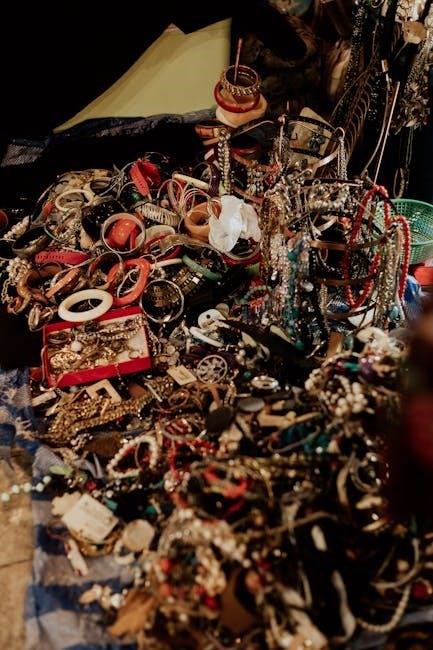Discover the art of identifying vintage and antique jewelry through this guide, exploring historical context, key factors in age determination, and recognizing unique design styles.
Understanding the Basics of Jewelry Classification
Jewelry classification is essential for identifying vintage and antique pieces. It involves categorizing based on historical periods, materials, and design elements. Understanding these basics helps distinguish between eras, such as Victorian or Art Deco, and recognize materials like gold, silver, or platinum. Classification also considers craftsmanship, hallmarks, and cultural influences. By mastering these fundamentals, collectors can accurately assess and authenticate jewelry, whether it’s a rare antique or a unique vintage find.
The Importance of Historical Context in Jewelry Identification
Historical context is crucial for accurately identifying vintage and antique jewelry. Understanding the cultural, social, and artistic movements of specific eras helps date pieces and authenticate their origins. For instance, Victorian jewelry often features mourning motifs, while Art Deco pieces emphasize geometric designs. Knowing these historical markers aids in distinguishing genuine items from reproductions. Additionally, historical context reveals the significance of materials and techniques, such as the rise of platinum in the Edwardian period. This knowledge enhances the appreciation and valuation of jewelry, making it indispensable for collectors and historians alike.
Key Factors in Determining Jewelry Age and Authenticity
When determining the age and authenticity of jewelry, several factors come into play. Hallmarks, signatures, and stamps are critical for identifying makers and periods. Materials and construction techniques, such as the use of platinum or hand-crafted details, often indicate era-specific craftsmanship. Design styles, like Art Nouveau or Art Deco motifs, also provide clues. Wear patterns, patina, and repairs can reveal a piece’s history. Documentation or provenance further corroborates authenticity. Combining these elements ensures accurate identification and valuation of vintage and antique jewelry.
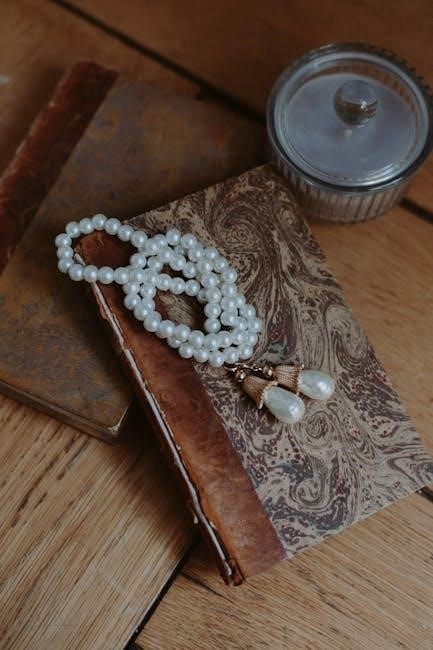
Defining Vintage and Antique Jewelry
Vintage jewelry is typically 40+ years old, while antique jewelry is over 100 years old, each offering unique historical significance and value in identification.
Distinguishing Between Vintage and Antique Jewelry
Vintage jewelry is typically defined as being over 40 years old, often reflecting mid-century modern designs, while antique jewelry must be at least 100 years old. The distinction lies not only in age but also in historical context, design styles, and materials. Vintage pieces often feature retro influences, such as bold geometric patterns, whereas antique jewelry may showcase intricate craftsmanship from earlier eras, like Victorian or Art Nouveau. Understanding these differences helps collectors and enthusiasts accurately identify and value their treasured items, appreciating their unique historical significance.
Age Requirements for Antique Jewelry
Antique jewelry is defined as pieces that are at least 100 years old, marking a clear distinction from vintage jewelry, which is typically over 40 years old. This 100-year threshold is a universal standard, ensuring historical significance and rarity. The age requirement reflects the craftsmanship and design of bygone eras, often tied to specific historical periods. Meeting this criterion is essential for classification, authentication, and determining market value, as it verifies the piece’s heritage and cultural importance.
Historical Periods and Their Influence on Jewelry Design
Historical periods profoundly shaped jewelry design, creating distinct styles that reflect their cultural and social contexts. The Victorian era, for example, favored intricate details and symbolic motifs, while Art Nouveau emphasized flowing, organic forms. Art Deco brought geometric patterns and bold gemstones, influenced by modernity and glamour. Each period left a unique imprint, allowing experts to trace a piece’s origins and authenticity. Understanding these design evolutions is crucial for identifying and valuing vintage and antique jewelry, as they embody the artistic and historical essence of their times.
Identifying Jewelry by Historical Period
Historical periods like Victorian, Art Nouveau, and Art Deco left distinct marks on jewelry design, offering clues for identification through style, materials, and cultural influences.
Victorian and Edwardian Jewelry Styles
Victorian jewelry, spanning the 19th century, is characterized by intricate designs, mourning motifs, and symbolic elements like seed pearls and jet. The Edwardian era, early 20th century, favored delicate filigree, lace-like patterns, and pearls, reflecting a more restrained elegance. Both periods emphasize emotional and symbolic expression, with Victorian pieces often darker and more romantic, while Edwardian styles are lighter and more refined, showcasing craftsmanship and cultural influences of their time. These distinct aesthetics aid in identifying jewelry from these periods.
Art Nouveau and Art Deco Influences
Art Nouveau jewelry, popular in the late 19th to early 20th centuries, features flowing, organic designs inspired by nature, such as flowers and curves. It often incorporates glass and enamel. Art Deco, emerging in the 1920s, emphasizes geometric shapes, symmetry, and modern materials like platinum and chrome. Influenced by ancient cultures and the Machine Age, Art Deco jewelry is bold and structured, often with diamonds and onyx. These styles reflect distinct cultural and aesthetic shifts, aiding in identifying pieces from these transformative periods in jewelry history.
Mid-Century Modern and Retro Jewelry Designs
Mid-Century Modern jewelry, popular from the 1940s to 1960s, is characterized by minimalist designs, clean lines, and an emphasis on functionality. It often features streamlined silhouettes and organic motifs, with materials like gold and silver. Retro jewelry, spanning the 1930s to 1950s, is more elaborate, with bold statements, floral motifs, and vibrant gemstones. Both styles reflect post-war cultural shifts, with Retro jewelry often incorporating platinum and diamonds, while Mid-Century Modern pieces embraced simplicity and modernity, influenced by wartime rationing and a focus on wearable art.
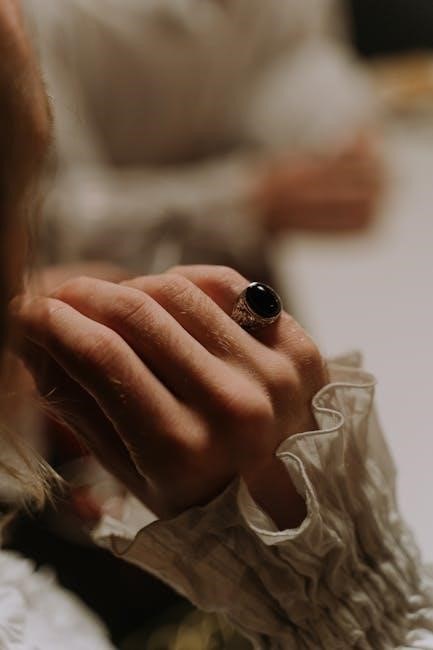
Jewelry Materials and Construction Techniques
Explore the craftsmanship behind vintage and antique jewelry, focusing on precious metals, gemstones, and intricate settings, which reveal the era’s techniques and material preferences.
Recognizing Precious Metals in Vintage Jewelry
Identifying precious metals in vintage jewelry involves examining hallmarks, patinas, and construction techniques. Gold, silver, and platinum are common, with hallmarks indicating purity and origin. Regional hallmarks vary, aiding in provenance. Vintage pieces often feature soldering or riveting, while modern items may use casting. Precious metals develop distinctive patinas over time, enhancing authenticity. Testing methods like acid or magnetism can confirm metal types. Understanding these elements helps in distinguishing genuine vintage pieces from reproductions, ensuring accurate identification and valuation.

Identifying Gemstones and Their Settings
Identifying gemstones and their settings is crucial for authenticating vintage jewelry. Researching historical periods helps recognize popular stones and mounting styles. For example, Art Nouveau often featured naturalistic designs with pearls and opals, while Art Deco emphasized geometric patterns with diamonds and onyx. Examining the stone’s clarity, cut, and color under magnification can reveal its authenticity. Settings like prong, bezel, or pave are common in vintage pieces. Hallmarks and signatures on settings can also indicate the era and craftsmanship, aiding in accurate identification and valuation.
Understanding Antique Jewelry Making Methods
Antique jewelry making often involved handcrafted techniques like hand-engraving, filigree, and enameling, reflecting the skill of master craftsmen. Victorian-era pieces frequently used intricate settings and mourning jewelry with hairwork. Art Nouveau emphasized organic forms with flowing lines, while Art Deco introduced geometric patterns and bold metals. Understanding these historical methods aids in authenticating pieces and appreciating their craftsmanship, distinguishing them from modern reproductions. These techniques, often labor-intensive, highlight the artistry and cultural influences of their time, making each piece a testament to its era’s aesthetic values.

Hallmarks and Signatures in Vintage Jewelry
Hallmarks and signatures are crucial for authenticating vintage jewelry, revealing maker identity and metal content. They often include stamps, initials, or logos, aiding in verifying piece legitimacy and provenance.
Deciphering Hallmarks and Maker’s Marks
Hallmarks and maker’s marks are essential for identifying vintage jewelry, providing clues about its origin, materials, and authenticity. Hallmarks often indicate metal purity, such as “750” for 18k gold or “925” for sterling silver. Maker’s marks, like initials or logos, reveal the jeweler or designer. Using advanced search techniques with Boolean operators and exact phrase searches can help researchers locate databases or reference books to decode these marks. This process aids in verifying the piece’s legitimacy and historical context, crucial for collectors and appraisers alike.
Signature Styles of Notable Jewelry Designers
Recognizing the signature styles of renowned jewelry designers is crucial for authenticating vintage and antique pieces. Designers like Cartier, Tiffany & Co., and Chanel often incorporated distinctive motifs, such as Art Deco geometry or naturalistic designs. Studying these unique styles helps identify pieces and verifies their provenance. Advanced search techniques, such as using Boolean operators, can aid in finding detailed databases or reference materials. Understanding these signatures enhances the ability to distinguish genuine works from reproductions, making it invaluable for collectors and historians in appraising and valuing jewelry.
Regional Hallmarks and Their Significance
Regional hallmarks are essential for tracing the origin and authenticity of vintage and antique jewelry. These marks vary by country and era, often indicating metal content or craftsmanship standards. Advanced search techniques, like using Boolean operators, can help locate detailed databases or reference materials. Understanding regional hallmarks aids in identifying pieces, verifying provenance, and distinguishing genuine items from reproductions. This knowledge is vital for collectors and historians, enhancing the ability to appraise and value jewelry accurately.
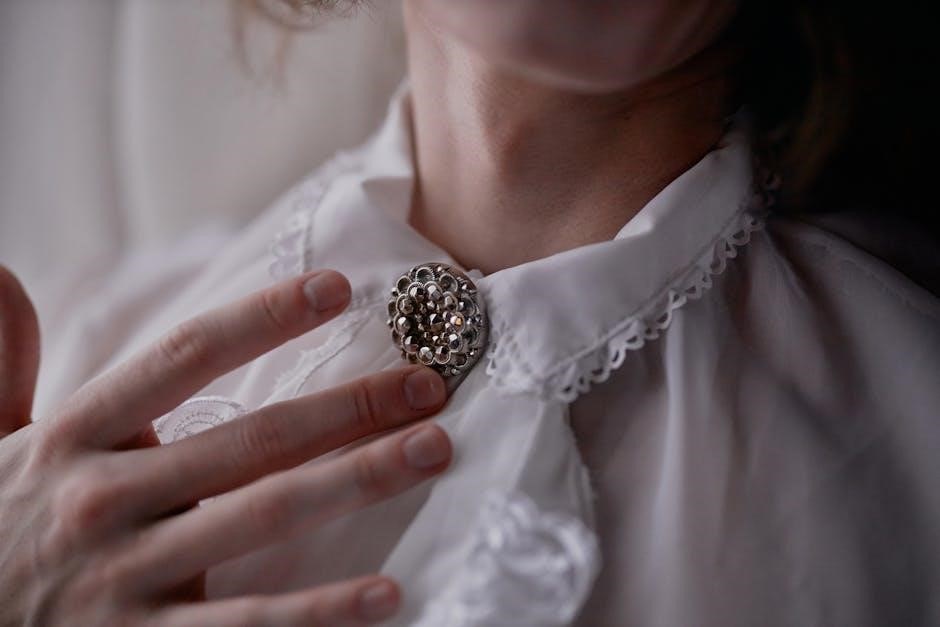
Evaluating Jewelry Condition and Wear
Evaluating jewelry condition involves assessing wear, damage, and restoration. Signs like patina, scratches, and missing stones affect value. Proper examination ensures accurate appraisals and preservation.
Assessing the Physical Condition of Antique Jewelry
Evaluating the physical condition of antique jewelry involves checking for signs of aging, wear, and potential damage. Look for patina, scratches, or missing components like stones or clasps. Examine the metal for bends, corrosion, or repairs. Assessing the overall integrity and originality is crucial, as these factors significantly impact the piece’s value. A detailed examination under magnification, using tools like a jeweler’s loupe, can reveal hidden flaws or restorations, ensuring an accurate appraisal of the jewelry’s condition and authenticity.
Common Signs of Wear and Repair
Antique jewelry often shows signs of wear, such as scratches, dents, or patina, which naturally develop over time. Missing or loose gemstones, worn prongs, or corroded clasps are also common. Repairs like soldering, re-tipping prongs, or replacing missing parts may indicate previous restoration efforts. These signs don’t necessarily diminish value but rather tell the story of the piece’s history. Inspecting for these indicators helps determine the jewelry’s originality and condition, guiding its appraisal and preservation.
Restoration Techniques and Their Impact on Value
Restoration techniques, such as cleaning, polishing, or soldering, can preserve the integrity of vintage jewelry but may impact its value. Minor restorations, like re-tipping prongs or replacing worn findings, are often accepted if done skillfully. However, extensive alterations, such as replacing original stones or altering designs, can significantly reduce value. Over-restoration can diminish authenticity, making it harder to appraise the piece accurately. Collectors typically prefer jewelry in its original condition, so the extent and quality of restoration are critical factors in determining value and desirability.
Market Value and Appraisal
Market value of vintage and antique jewelry is determined by factors like rarity, condition, and historical significance. Professional appraisals provide accurate valuations, guiding buyers and sellers.
Factors Influencing the Value of Vintage Jewelry
The value of vintage jewelry is determined by several factors, including rarity, condition, and historical significance. Provenance, or the piece’s ownership history, can greatly impact its worth. Demand for specific styles or designers also plays a role. The quality of materials, such as precious metals and gemstones, is crucial, as is the craftsmanship and uniqueness of the design. Additionally, market trends and the presence of hallmarks or signatures can influence valuation. Proper documentation and appraisals further ensure accurate assessments of a piece’s value.
How to Get Your Jewelry Appraised
To appraise vintage jewelry, consult a certified gemologist or appraiser specializing in antique and vintage pieces. Ensure they examine the item for authenticity, checking hallmarks, signatures, and historical context. Provide documentation, such as provenance or repair records, to aid the evaluation. Appraisals typically include detailed descriptions, photographs, and market value assessments. Consider obtaining appraisals from multiple experts or through reputable organizations like the Gemological Institute of America (GIA) for unbiased and accurate valuations.
Understanding Market Trends in Antique Jewelry
Antique jewelry market trends reflect shifting consumer preferences, with demand often rising for pieces from popular historical periods, such as Art Deco or Victorian eras. Sustainability and ethical sourcing are increasingly influencing buyer behavior, driving interest in vintage over new luxury items. Factors like rarity, condition, and provenance significantly impact value. Regional demand varies, with certain designs gaining popularity in specific markets. Online platforms like Etsy and eBay have expanded accessibility, while auctions still dominate high-end sales. Staying informed about these trends can help collectors and sellers make informed decisions.
Research Tools and Resources
Utilize online databases, reference books, and expert communities for accurate jewelry identification. Tools like Google Image Search and Etsy can help verify authenticity and estimate value effectively.
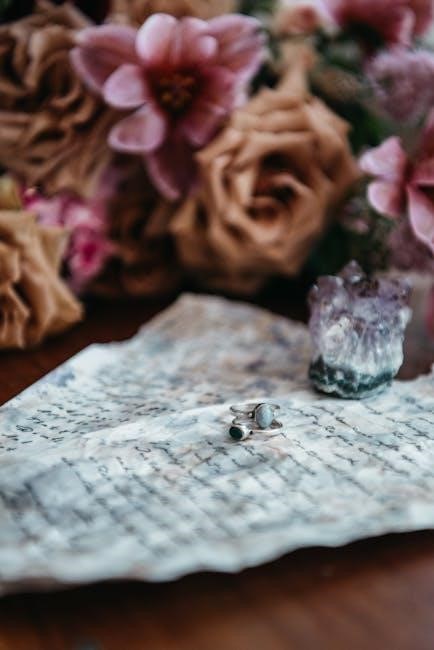
Using Online Databases for Jewelry Research
Online databases are invaluable for jewelry research, offering access to historical records, auction listings, and expert insights. Tools like Google Image Search and Etsy can help identify similar pieces and verify authenticity. Advanced search features, including Boolean operators, enable precise queries, narrowing results by era, material, or designer. These resources not only save time but also enhance accuracy, making them essential for collectors and researchers aiming to uncover the history and value of vintage and antique jewelry efficiently.
Reference Books for Antique Jewelry Identification
Reference books are essential tools for identifying antique jewelry, offering detailed insights into historical styles, materials, and craftsmanship. Notable publications include works by jewelry historians like Judith Miller and Diana Scarisbrick, which provide comprehensive guides to periods such as Art Nouveau and Art Deco. These books often feature high-quality images, hallmark databases, and timelines, aiding collectors in authenticating pieces and understanding their historical context. They are invaluable resources for determining provenance, dating, and the value of antique jewelry, making them indispensable for serious collectors and researchers.
Consulting Experts and Communities
Consulting experts and joining specialized communities is crucial for accurate vintage and antique jewelry identification. Jewelry historians, appraisers, and seasoned collectors offer invaluable insights, while online forums and collector groups provide platforms for sharing knowledge and validating finds. Professional organizations like the National Association of Jewelry Appraisers or the Antique Jewelry & Watch Guild can connect you with trusted experts. Engaging with these networks ensures access to extensive expertise, helping you authenticate pieces and understand their historical significance. This collaborative approach enhances your ability to identify and value jewelry effectively.
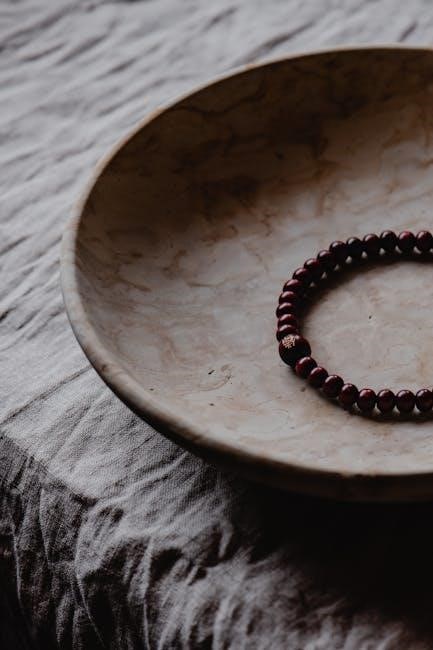
Authentication and Avoiding Counterfeits
Learn to authenticate vintage jewelry by examining hallmarks, signatures, and historical context. Verify documentation and watch for red flags like reproduction marks or unrealistic pricing.
Spotting Fake or Reproduction Jewelry
Identifying counterfeit or reproduction jewelry requires a keen eye for detail. Examine hallmarks, signatures, and historical context to verify authenticity. Look for inconsistencies in design, materials, or craftsmanship that deviate from the period. Use reverse image search to compare with authenticated pieces. Be cautious of overly polished or pristine items, as genuine antiques often show signs of age. Question unusually low prices or lack of documentation. Consulting experts and comparing with known examples can help confirm legitimacy and avoid misidentifying reproductions.

Verifying Authenticity Through Documentation
Documentation is crucial in confirming the authenticity of vintage and antique jewelry. Look for provenance, such as receipts, appraisals, or historical records linking the piece to a notable designer or era. Appraisals from reputable organizations, like the Gemological Institute of America (GIA), add credibility. Additionally, examine hallmarks, signatures, or stamps that align with the period. Cross-referencing with historical databases or library archives can further validate the piece’s origins. Proper documentation ensures the jewelry’s legitimacy and enhances its value in the market.
Red Flags in Vintage Jewelry Purchases
When purchasing vintage jewelry, be cautious of pieces with unclear or missing hallmarks, as this can indicate reproduction or misrepresentation. Overly polished items may hide signs of wear or damage. Avoid sellers who refuse to provide documentation or hesitate to disclose the jewelry’s history. Unusually low prices for high-quality pieces can signal authenticity issues. Additionally, inspect for modern materials or techniques inconsistent with the claimed era. Trustworthy sellers should be transparent about repairs or alterations. Always seek a second opinion or professional appraisal to ensure legitimacy.
Collecting and Preserving Vintage Jewelry
Properly store vintage jewelry in padded boxes or soft cloths to prevent damage. Avoid harsh chemicals and extreme temperatures. Clean gently and display securely to maintain value and integrity.
Building a Meaningful Jewelry Collection
Start by defining your focus, whether it’s a specific historical period, designer, or style. Set a budget and research thoroughly to understand market value and authenticity. Seek pieces that resonate personally, reflecting your taste or heritage. Learn about hallmarks, materials, and craftsmanship to make informed decisions. Consider the condition and rarity of items, as these impact value. Building a collection takes patience, but with dedication, it can become a cherished legacy that tells a story of timeless elegance and personal significance.
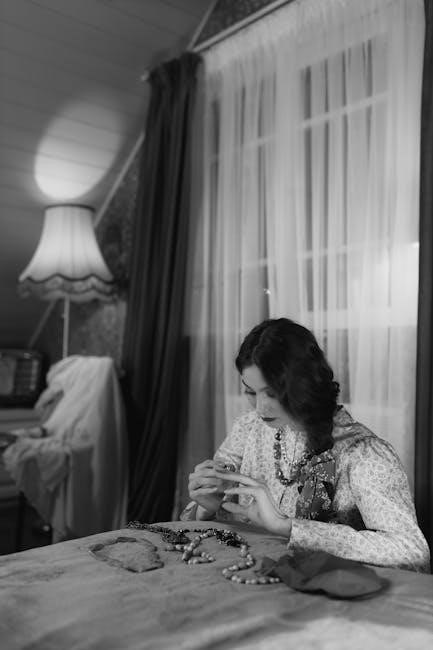
Proper Storage and Care Techniques
Store vintage and antique jewelry in a cool, dry place away from direct sunlight to prevent fading or damage. Use acid-free tissue or soft velvet pouches to separate pieces, avoiding contact that could cause scratches. Clean gently with a soft cloth, avoiding harsh chemicals or abrasive materials. For delicate or intricate designs, consider professional cleaning. Regularly inspect items for signs of wear or loosening and repair promptly to preserve their integrity and value over time.
Displaying Antique Jewelry Safely
Display antique jewelry in a cool, dry environment away from direct sunlight to prevent fading or damage. Use glass-front cases or acrylic displays with UV protection to maintain condition. Avoid overcrowding pieces, as this can cause scratching or tangling. For added security, consider using locked cases or tamper-proof mounts. Velvet or satin-covered surfaces can help prevent scratching. When showcasing, ensure each piece is securely fastened to prevent accidental loss. Regularly inspect displays for dust or moisture buildup to preserve the jewelry’s integrity and long-term value.
